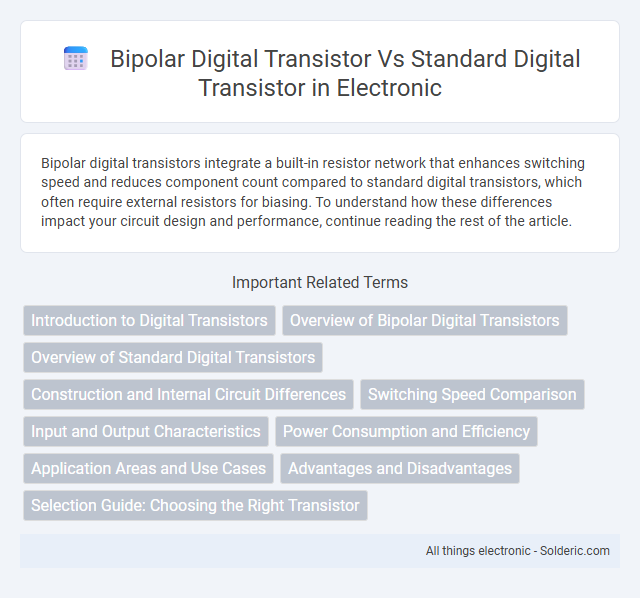Bipolar digital transistors integrate a built-in resistor network that enhances switching speed and reduces component count compared to standard digital transistors, which often require external resistors for biasing. To understand how these differences impact your circuit design and performance, continue reading the rest of the article.
Comparison Table
| Feature | Bipolar Digital Transistor | Standard Digital Transistor |
|---|---|---|
| Structure | Contains built-in resistors with a bipolar junction transistor (BJT) | Typically a BJT without integrated resistors |
| Built-in Resistors | Yes, includes base resistors for simplified input control | No, external resistors required |
| Switching Speed | Moderate switching speed | Varies, generally depends on external component design |
| Input Signal | Low input current needed due to integrated resistors | Higher input current required to drive the base |
| Application | Ideal for simple switching, logic level interfacing | Used where custom input control and external resistor configuration are preferred |
| Integration | Compact, all-in-one transistor-resistor solution | Discrete transistor requiring external components |
Introduction to Digital Transistors
Digital transistors integrate resistors with bipolar transistors in a single package, simplifying circuit design and reducing component count compared to standard digital transistors that typically require external biasing resistors. These devices offer faster switching speeds and improved noise immunity due to the integrated resistor network, enhancing overall performance in digital circuits. Incorporating both digital and bipolar transistor characteristics, digital transistors optimize current gain and voltage handling, making them ideal for efficient signal amplification and switching applications.
Overview of Bipolar Digital Transistors
Bipolar digital transistors integrate a built-in base resistor that simplifies circuit design by reducing the need for external components, enhancing switching speed and reliability compared to standard digital transistors. They typically feature a Darlington configuration, providing higher current gain and improved saturation voltage, which optimizes performance in low-voltage digital circuits. This integration results in better thermal stability and ease of use in microcontroller interfacing and high-speed digital switching applications.
Overview of Standard Digital Transistors
Standard digital transistors integrate a resistor network with a bipolar transistor, simplifying circuit design by eliminating the need for external base resistors. These transistors offer reliable switching performance with fixed gain, making them ideal for low-power digital applications. Your choice between bipolar digital and standard digital transistors should consider factors like integration level, speed, and built-in resistance for optimized circuit efficiency.
Construction and Internal Circuit Differences
Bipolar digital transistors integrate a built-in base resistor and sometimes a base-emitter resistor, simplifying external circuitry and improving switching performance, whereas standard digital transistors typically include only a base resistor. The internal circuit of a bipolar digital transistor features a Darlington or multi-transistor arrangement to enhance current gain and switching speed, while standard digital transistors rely on a single bipolar junction transistor with minimal internal components. Your choice depends on the desired ease of use and specific circuit requirements, as bipolar digital transistors reduce component count and ensure more stable operation in digital switching applications.
Switching Speed Comparison
Bipolar digital transistors exhibit faster switching speeds compared to standard digital transistors due to their integrated resistor networks that reduce delay during signal transitions. The intrinsic design of bipolar transistors allows for quicker charge carrier movement, resulting in enhanced performance in high-frequency applications. Standard digital transistors typically experience slower switching times because of higher base resistance and capacitance, which limit rapid switching efficiency.
Input and Output Characteristics
Bipolar digital transistors feature integrated base resistors, which provide more stable input current control and higher gain compared to standard digital transistors lacking internal resistors. The output characteristics of bipolar digital transistors typically exhibit faster switching speeds and lower saturation voltage, resulting in improved efficiency in digital circuits. Your choice between the two should consider input impedance requirements and switching performance to optimize circuit functionality.
Power Consumption and Efficiency
Bipolar digital transistors typically consume more power than standard digital transistors due to their inherent structure and continuous current flow in the base-emitter junction. Standard digital transistors, often designed with integrated resistors, enhance efficiency by reducing the need for external components and minimizing power loss during switching. Optimizing your circuit with standard digital transistors can lead to lower power consumption and improved overall efficiency.
Application Areas and Use Cases
Bipolar digital transistors excel in switching and amplification tasks within audio equipment, motor control circuits, and power management systems due to their integrated resistors that simplify circuit design. Standard digital transistors find widespread use in general-purpose applications such as signal processing, logic circuits, and microcontroller interfaces because of their basic structure and reliability. Your choice depends on the need for compactness and ease of integration (favoring bipolar digital transistors) versus versatility and cost-efficiency offered by standard digital transistors.
Advantages and Disadvantages
Bipolar digital transistors offer faster switching speeds and higher current gain compared to standard digital transistors, making them suitable for high-frequency applications and enhanced signal amplification. However, bipolar types tend to consume more power and generate greater heat, which can impact overall efficiency and thermal management in compact circuits. Standard digital transistors provide simpler integration with lower power consumption but typically exhibit slower switching times and less gain, limiting their use in precision or high-speed tasks.
Selection Guide: Choosing the Right Transistor
When selecting between a bipolar digital transistor and a standard digital transistor, consider the switching speed, gain, and application requirements. Bipolar digital transistors offer higher gain and faster switching suitable for high-frequency circuits, while standard digital transistors provide simpler integration with moderate gain for general-purpose switching. Evaluate parameters such as collector current, voltage ratings, and package type in the selection guide to ensure optimal performance and reliability in your specific design.
Bipolar digital transistor vs Standard digital transistor Infographic

 solderic.com
solderic.com